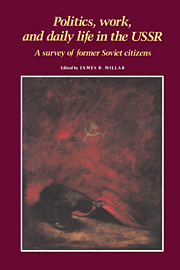Book contents
- Frontmatter
- Contents
- Foreword
- List of contributors
- PART I INTRODUCTION
- PART II POLITICS: SOURCES OF REGIME SUPPORT
- PART III WORK: ECONOMIC/DEMOGRAPHIC TRENDS
- PART IV LIFE: SOCIAL STATUS, ETHNIC RELATIONS, AND MOBILIZED PARTICIPATION
- 9 Perceptions of social status in the USSR
- 10 Nationality policy and ethnic relations in the USSR
- 11 Mobilized participation and the nature of the Soviet dictatorship
- Appendix A The SIP General Survey sample
- Appendix B Response effects in SIP's General Survey of Soviet emigrants
- Glossary
- General bibliography of Soviet Interview Project publications
- Index
11 - Mobilized participation and the nature of the Soviet dictatorship
Published online by Cambridge University Press: 21 March 2010
- Frontmatter
- Contents
- Foreword
- List of contributors
- PART I INTRODUCTION
- PART II POLITICS: SOURCES OF REGIME SUPPORT
- PART III WORK: ECONOMIC/DEMOGRAPHIC TRENDS
- PART IV LIFE: SOCIAL STATUS, ETHNIC RELATIONS, AND MOBILIZED PARTICIPATION
- 9 Perceptions of social status in the USSR
- 10 Nationality policy and ethnic relations in the USSR
- 11 Mobilized participation and the nature of the Soviet dictatorship
- Appendix A The SIP General Survey sample
- Appendix B Response effects in SIP's General Survey of Soviet emigrants
- Glossary
- General bibliography of Soviet Interview Project publications
- Index
Summary
How shall we characterize contemporary regime–society relations in the Soviet Union? In the 1950s Soviet specialists and students of comparative politics more broadly were agreed on the basic outlines of How the Soviet System Works, to use the title of the summary volume of the Harvard Project on the Soviet Social System (Bauer, Inkeles, and Kluckhohn 1959). The Soviet Union was a novel dictatorial form in which the regime insisted on, and accomplished, the mobilization to its purposes of the entire society. This pattern of regime–society relations differentiated the Soviet totalitarian system and traditional autocracy, which discourages mobilization of elites and masses and is content with citizen acquiescence.
Changes in the Soviet Union, developments in the social sciences, and improvements in the international climate all served to bring the totalitarian model under severe scrutiny in the 1960s. With the assimilation of the implications of the end of terror as an instrument of political control, there was a newfound sensitivity to the increased social differentiation and articulation of a growingly complex industrial society, along with renewed attention to the persistent impact of traditional Russian culture on the Soviet polity. If the Soviet system under Stalin has been described in Marxian terms as the revenge of the superstructure, the period from the 1960s forward might be described as the rediscovery of the base. Throughout the latter period, however, specialists and generalists alike (cf. Dahl 1971) have continued to describe the Soviet Union in terms that stress, inter alia, the extent to which it is a highly participatory, mobilized, political system.
- Type
- Chapter
- Information
- Politics, Work, and Daily Life in the USSRA Survey of Former Soviet Citizens, pp. 332 - 353Publisher: Cambridge University PressPrint publication year: 1987
- 7
- Cited by



